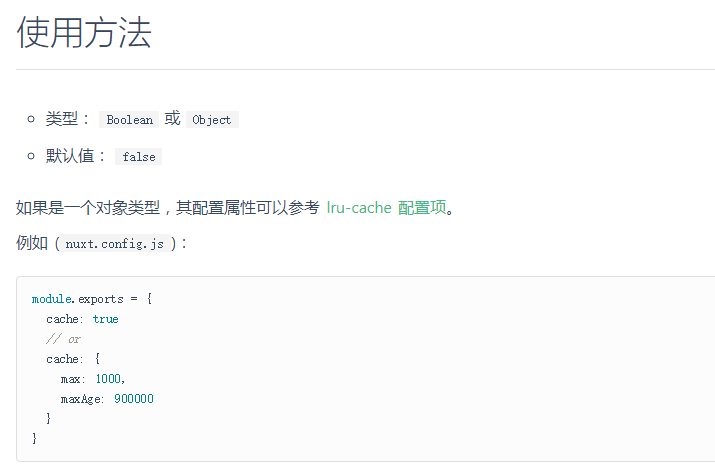nuxt.js服务端缓存lru-cache
对于部分网页进行服务端的缓存,可以获得更好的渲染性能,但是缓存又涉及到一个数据的及时性的问题,所以在及时性和性能之间要有平衡和取舍。
官方文档里面写的使用方法

按照这个配置,试过了没什么用,但是从文档的另外一个地方示例里的代码是能够正常运行的,需要配置的地方有两个:
在使用之前,这个缓存组件并没有默认集成,需要自己安装后才可以使用
npm install lru-cache -s
1.nuxt.config.js
module.exports = { render: { bundleRenderer: { cache: require('lru-cache')({ max: 1000, maxAge: 1000 * 60 * 15 }) } } }
2.vue页面上要配置一个单页的唯一key,通过serverCacheKey()方法返回这个唯一KEY,示例里面用一个时间值,每10秒变化一次来控制缓存的更新频率
<template>
<div>
<h1>Cached components</h1>
<p>Look at the source code and see how the timestamp is not reloaded before 10s after refreshing the page.</p>
<p>Timestamp: {{ date }}</p>
</div>
</template>
<script>
export default {
name: 'date',
serverCacheKey () {
// Will change every 10 secondes
return Math.floor(Date.now() / 10000)
},
data () {
return { date: Date.now() }
}
}
</script>
在我按照文档完成这个范例后,刷新网页,其实这个date并没有10秒更新一次,github上已经有人提出这个问题了,按照作者的说法,如果是chrome浏览器可以通过view-source:http://localhost:3000/这个方式去验证,我试了一下的确是10秒更新一次。
我可能需要的是 asyncData() 通过异步获取其他服务器的数据能够被缓存起来,防止每次只要有用户访问网页,但是这个缓存的配置,并不是缓存了所有的信息,每次访问asyncData()还是会执行,然后服务器获取一遍数据....
lru-cache包含的功能可以自己实现这部分的功能,例如每次的get请求缓存
import axios from 'axios'; import LRU from 'lru-cache'; const cache = LRU({ max: 1000, maxAge: 1000 * 10, }); export const get = async (url) => { let data = cache.get(url); if (data) { return JSON.parse(data); } const res = await axios.get(url); data = res.data; cache.set(url, JSON.stringify(data)); return data; };
或者只对lru-cache进行一个简单的包装,在需要使用的地方再使用
// 运行与服务端的js // node.js lru-cache import LRU from 'lru-cache' const lruCache = LRU({ // 缓存队列长度 max: 2000, // 缓存有效期 maxAge: 60000 }) export const cache = { get: function (key) { let result = lruCache.get(key) if (result) { return JSON.parse(result) } return null }, set: function (key, value) { if (value) { lruCache.set(key, JSON.stringify(value)) return true } return false } }





【推荐】国内首个AI IDE,深度理解中文开发场景,立即下载体验Trae
【推荐】编程新体验,更懂你的AI,立即体验豆包MarsCode编程助手
【推荐】抖音旗下AI助手豆包,你的智能百科全书,全免费不限次数
【推荐】轻量又高性能的 SSH 工具 IShell:AI 加持,快人一步
· .NET Core 中如何实现缓存的预热?
· 从 HTTP 原因短语缺失研究 HTTP/2 和 HTTP/3 的设计差异
· AI与.NET技术实操系列:向量存储与相似性搜索在 .NET 中的实现
· 基于Microsoft.Extensions.AI核心库实现RAG应用
· Linux系列:如何用heaptrack跟踪.NET程序的非托管内存泄露
· TypeScript + Deepseek 打造卜卦网站:技术与玄学的结合
· Manus的开源复刻OpenManus初探
· AI 智能体引爆开源社区「GitHub 热点速览」
· 三行代码完成国际化适配,妙~啊~
· .NET Core 中如何实现缓存的预热?